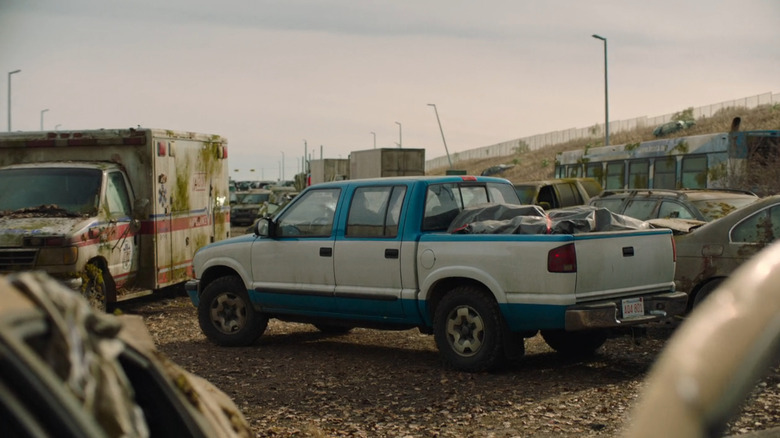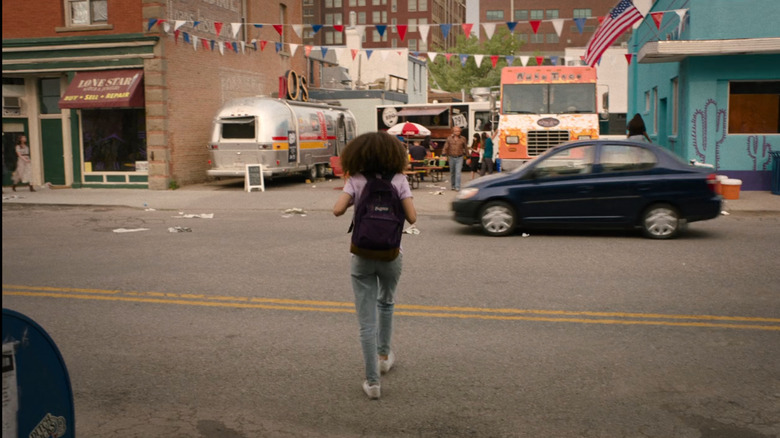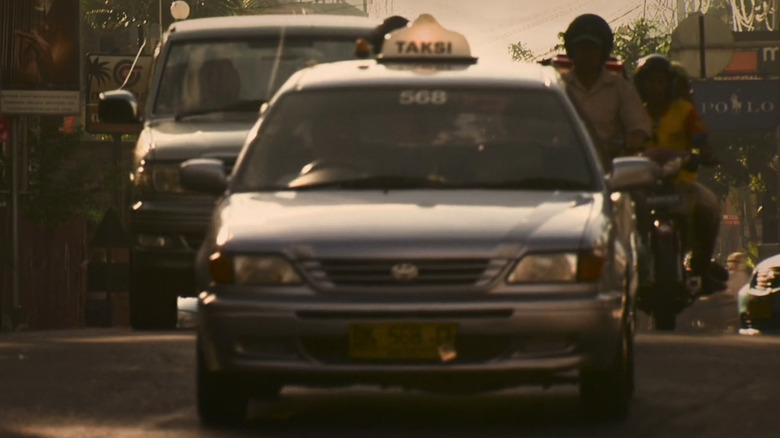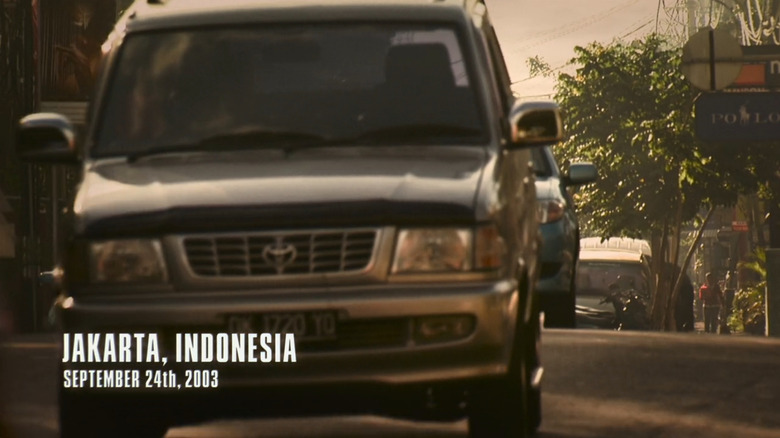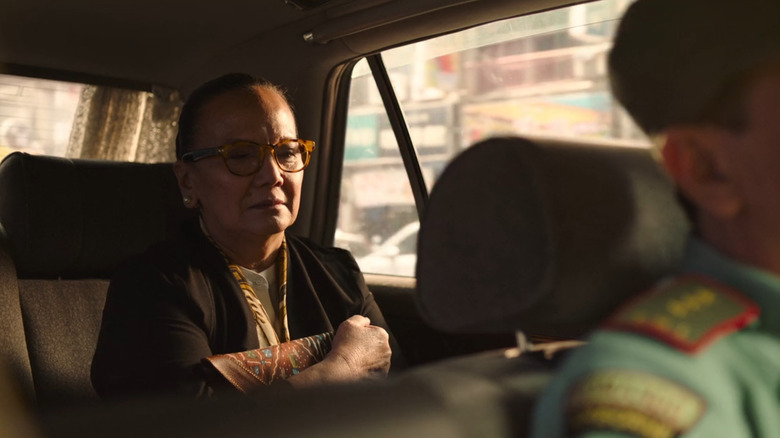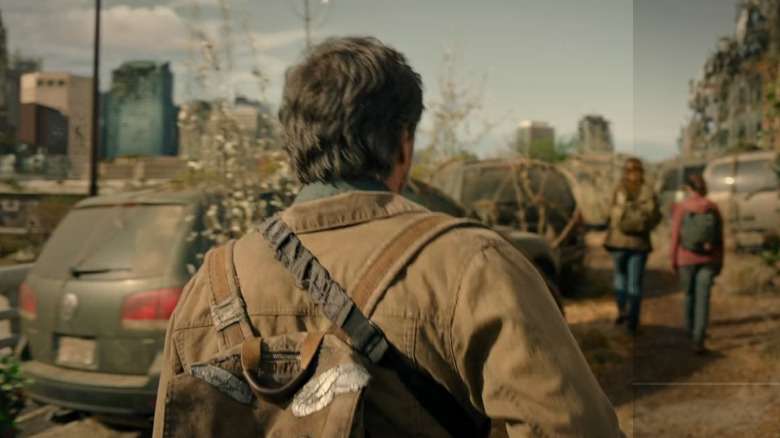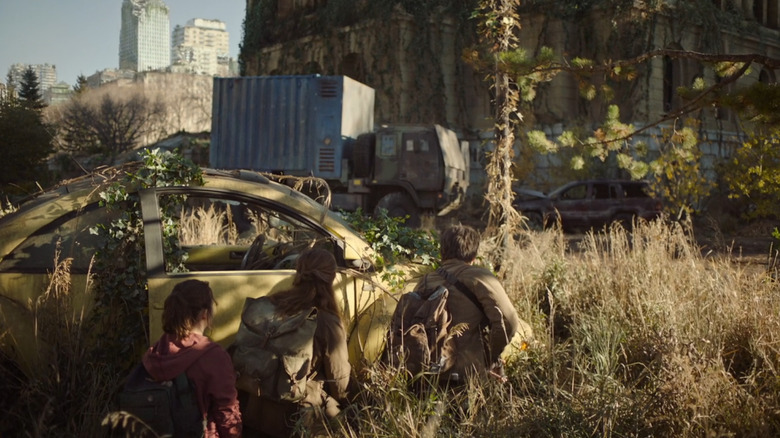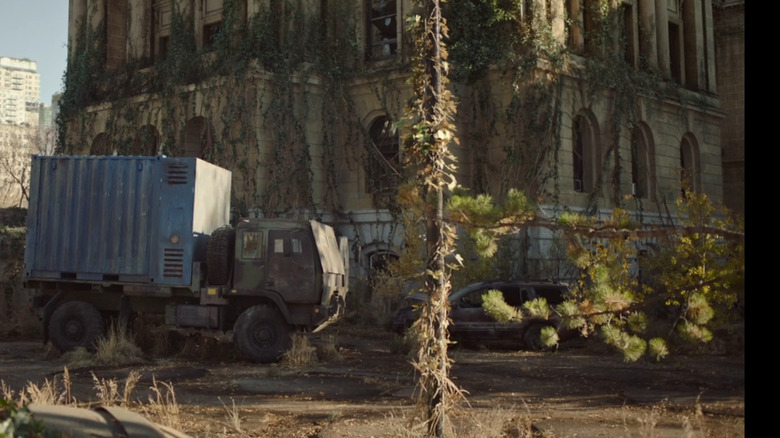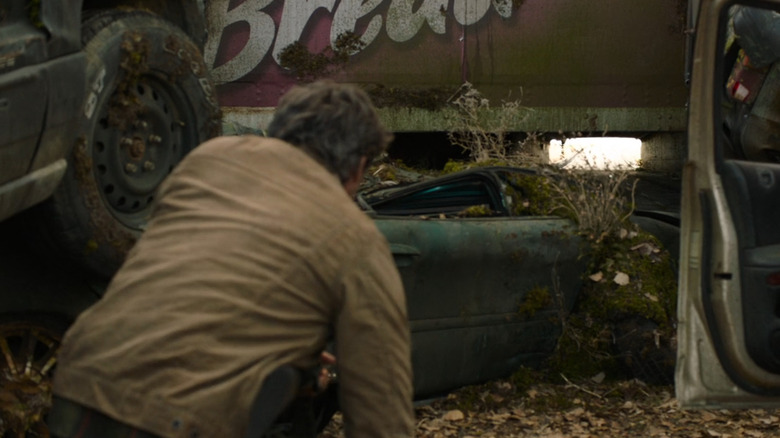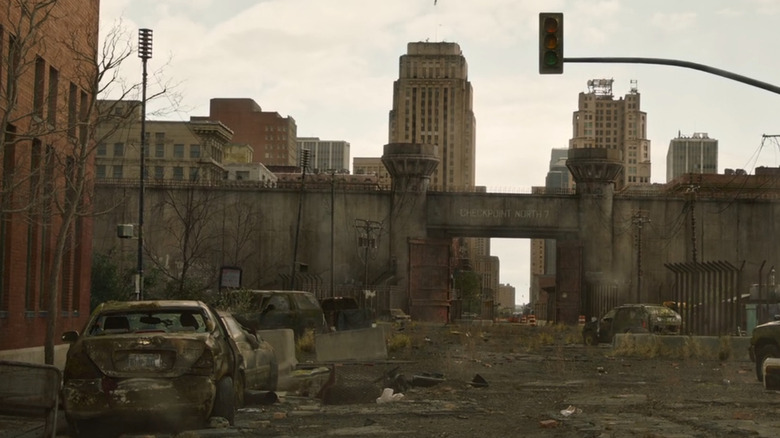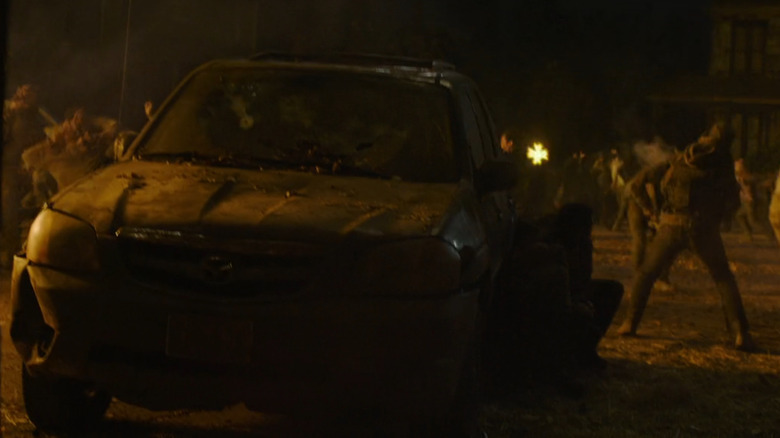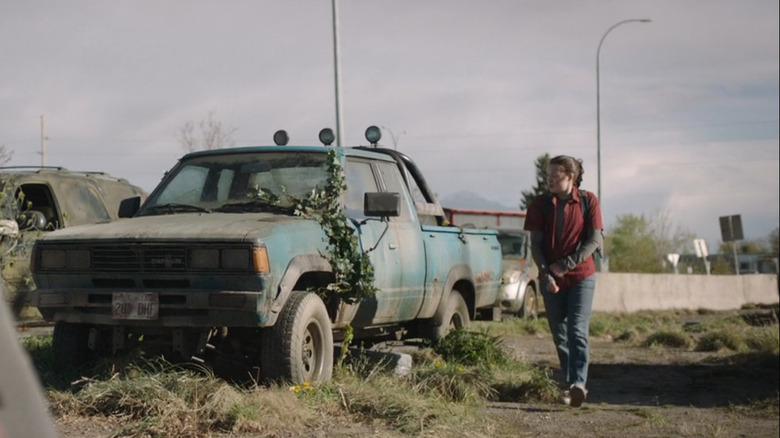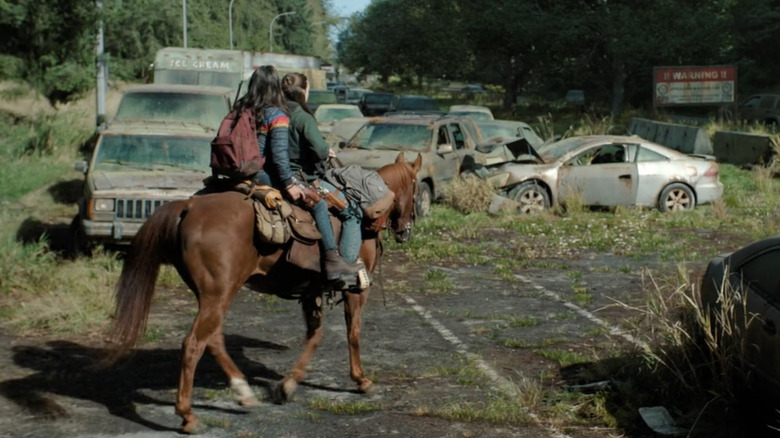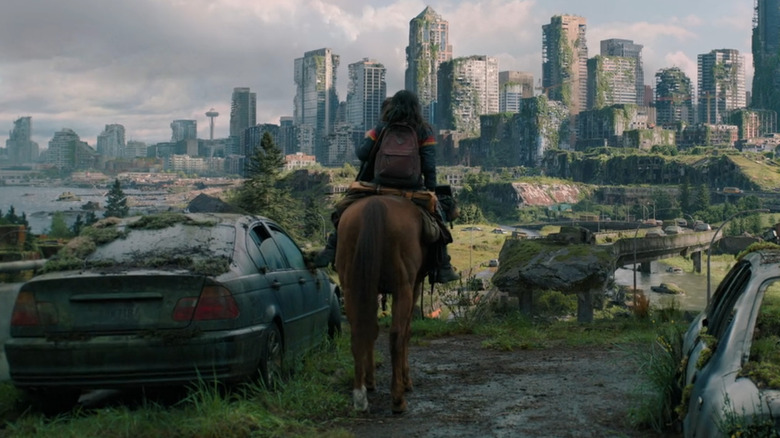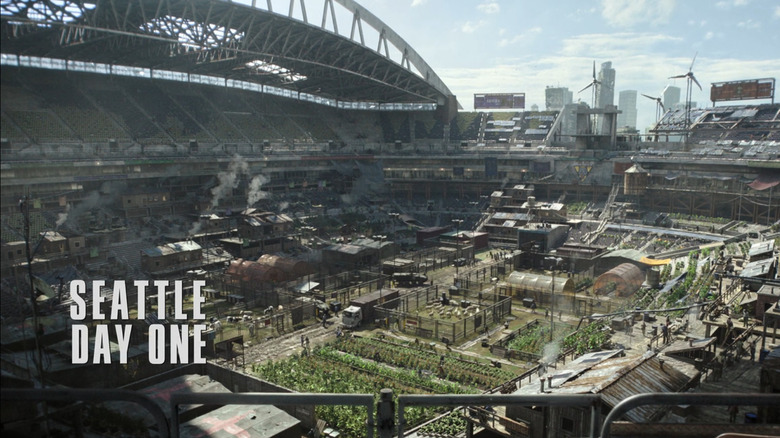13 Cars You Might Have Missed In The Last Of Us Seasons 1 And 2
In "The Last of Us," most cars didn't survive the apocalypse so much as they became part of the scenery. They're the skeletal remains of a lost world, with their rusted frames now just fancy planters for mutant vegetation. Doors? Missing. Windows? Shattered. Hopes and dreams of whoever owned them? Long gone. It's not all wrecks and rust, though. Every now and then, you step back in time, right into the brief moments before everything started falling apart. A 2000 Toyota Soluna taxi rolls through Jakarta traffic, still making its rounds. A Toyota Echo bumbles down the road, blissfully unaware of how this all ends. There's a strange calm to it, but only if you forget what's just around the corner.
Flash forward 20 years, and anything still running is either a military vehicle, a Frankenstein monster of scavenged parts and desperation, or Bill's legendary S-10. Yet the real poetry is in the background. An overturned minivan? A family's final road trip. That bullet-riddled sedan? Someone's last stand. And that one weirdly pristine BMW? Probably serving as a Clicker's weekend getaway by now. So, here's to the forgotten vehicles of "The Last of Us" — most of them dead, a few still hanging on, and one glorious Chevy that refuses to quit. Because in this world, even the cars have to fight to survive ... or at least make decent cover during a firefight.
2000 Toyota Echo
In the first episode, Joel's daughter, Sarah, crosses the street on a birthday mission: getting her dad's broken watch fixed. The scene is quiet — normal, even — with sunlight on the pavement, shops open, and life still moving. A 2000 Toyota Echo buzzes past in the background, easy to miss and just as unremarkable as it was in real life. The Echo was meant to be Toyota's budget-friendly answer for young buyers who couldn't afford a Camry. Instead, it became a masterclass in how to build a car that absolutely nobody wanted.
Everything about the Echo screamed "We gave up." The exterior styling looked like someone sketched a car on a napkin and called it good. The interior felt like it was assembled from leftover Happy Meal toys. Even desperate college students took one test drive and decided that walking built character. In the real world, the Echo failed because nobody wanted boring. Turns out, people actually like their cars to have a little soul, even if they're cheap. But in that moment on "The Last of Us," boring was still an option. And by nightfall, everyone would wish for boring again.
2000 Toyota Soluna
Wait, what the heck is a Toyota Soluna? Yeah, that was probably your exact reaction when this little taxi zipped past during those opening moments of the Jakarta flashback. Don't feel bad. Unless you've spent time in Thailand, you've probably never seen one of these things in your life. But here's the thing: The Soluna was basically a Tercel in disguise, with just enough changes to the front and rear to pretend it was something new.
Toyota built the Soluna specifically for the Thai market from 1997 to 2003, prioritizing affordability over literally everything else. Think of it as the automotive equivalent of instant ramen, but with better reliability. Yet there it was — the last normal taxi in human history, ferrying some poor soul home while Cordyceps brewed in a lab across town. The irony is almost poetic: humanity's final hours, witnessed by the automotive equivalent of white noise.
2000 Toyota Kijang
The moment the Soluna vanishes, here comes another Southeast Asian icon: the Toyota Kijang. This thing doesn't just cruise by casually, either. It rolls through the scene with the unshakeable swagger of something that's survived everything and knows it's got more left in the tank. Spoiler alert: That swagger has nothing to do with aesthetics.
Like many of the strangest Toyotas sold through the years, the Kijang isn't winning any beauty contests. With its tall, boxy profile and awkwardly upright stance, it looks like someone took a regular van and stretched it vertically in Photoshop. The proportions are all wrong — too narrow, too tall — like a vehicle designed by a committee that had never actually seen a car before.
But the Kijang has been a staple of Indonesian roads for decades, despite looking like automotive origami gone wrong. It's not flashy. It's not fast. But it's unreasonably durable and endlessly useful. This thing was the MVP of family road trips, mobile vendors, and rural taxi routes long before any infected showed up. And in true Kijang fashion, it shows up in "The Last of Us" like, "Yeah, I've seen worse."
1997 Toyota Century
Of course "The Last of Us" would choose Japan's most exclusive luxury sedan to usher in the apocalypse. When that obsidian-black 1997 Toyota Century collects Professor Ratna, it's the last bit of order before everything falls apart.Toyota designed the Century to block out the noise, literally and figuratively. Jacquard wool seats soak up sound. The V12 barely makes a noise. And the doors? They close like a vault.
Every detail — from the electronic skyhook air suspension to the crystal dashboard clock — exists to cushion its passengers from the real world. And now? It's ferrying a mycologist to deliver the ultimate bad news. The genius is in the contrast. While Jakarta's streets buzz with normal life, this stately sedan moves like a shadow. The same cabin that once carried politicians now holds the scientist who's about to confirm humanity's expiration date. And still, it glides because that's what a Century does. Even when carrying the end of the world, some things never break character.
2004 Volkswagen Toureg
On their trek to the Massachusetts State House, Tess is getting to know Ellie. And Joel's trailing behind like a one-man firing squad, ready to end the conversation permanently. In the background? A Volkswagen Touareg, built for adventures, yet left behind to rot despite its legendary German over-engineering.
Launched in the early 2000s, the Touareg was Volkswagen's attempt to go premium without totally losing the plot. Co-developed with Porsche, it had serious off-road capability wrapped in soft-touch leather and polite suburbia vibes. It was a car for people who wanted to tow a trailer through the Alps, but mostly used it for Target runs. Somewhere between rugged and refined, it never quite picked a lane, which makes its quiet role in "The Last of Us" all the more perfect.
It's not blown up. It's not covered in spores. It's just ... there. Untouched, unfazed, like the last person to drive it abandoned it mid-errand and never came back. And honestly? That tracks. In a world where everything's either on fire or rotting, the Touareg just blends in, as it's too solid to be destroyed, yet too bland to be looted. A forgotten SUV in a forgotten world, still waiting for someone to argue about the MPG.
1999 Volkswagen New Beetle
After making it through the treacherous museum, Joel, Tess, and Ellie finally reach the Massachusetts State House, hoping to find the Fireflies. But something's clearly wrong. As they cautiously approach, they quickly duck for cover behind a very recognizable 1999 Volkswagen New Beetle. Bright yellow. Round as ever. Parked like it still thinks this is a normal Tuesday.
When the New Beetle hit the streets in the late '90s, it was all about fun and nostalgia. So there's something darkly funny about it becoming a makeshift barricade. This Beetle was designed to be cute. It's a throwback to happier times, marketed to people who thought "flower vase on the dashboard" was a legitimate selling point. Now it's a bullet magnet, with its cheerful paint job flaking under the weight of the apocalypse. The owner probably parked it here for a quick coffee run, never imagining it would one day shield three fugitives from a missing militia.
1999 Jeep Grand Cherokee
While the trio huddles behind the New Beetle, completely focused on their missing Firefly contacts, they're missing an even more haunting sight. Tucked behind the trees near the State House, a 1999 Jeep Grand Cherokee sits with its hood raised like a white flag — one final, frantic attempt to escape. Most of the vehicle is obscured by foliage, but that open hood says everything. This wasn't planned parking. Nope, this was sheer panic. Someone's Cherokee died at the worst possible moment, right when they needed it most.
Imagine their shock. The Grand Cherokee was supposed to be reliable. It's the kind of SUV that started up without drama, got you through bad weather, and never left you stranded. But even the most dependable vehicles have their limits, and this one picked the absolute worst day in human history to finally give up. So there it sits, hood gaping open like a scream. Someone's last-ditch effort to coax life back into the engine before everything went to hell. Did they get it running? Did they make it out on foot? Or are they still in there, part of the landscape now?
1996 Ford Taurus
On their way to Wyoming, Joel and Ellie hit a snag. The tunnel into the Kansas City ruins dead-ends in wreckage. A jackknifed Sara Lee semi truck stretches across the underpass, sealing it off completely. And beneath its trailer, wedged hard into the pavement, is a dark green 1999 Ford Taurus. Whatever happened, it happened fast. The Taurus didn't stand a chance, nor did the occupants, likely still trapped inside.
Before Ford discontinued the Taurus, it was once everywhere. Dark green with a probably-awful tan interior, it was the go-to car for rental fleets, grandparents, and anyone who needed four doors without joy. It was never glamorous, just endlessly available. And now it's pinned under 40,000 pounds of baked goods, sealing off the only clear path into the city. It's a brutal scene, and the kind of moment "The Last of Us" handles so well: violence without spectacle. No chase or explosion. Just a once-ubiquitous family car flattened under a delivery truck, quietly reminding you how fast normal life got snuffed out.
2004 Chevrolet Epica
As Joel and Ellie roll into the ruins of Kansas City, they pause to regroup near what's left of a QZ checkpoint, confused, off-course, and surrounded by silence. It's here, just before the ambush, that a 2004 Chevrolet Epica lurks roadside, camouflaged by its own mediocrity just like always. You'd be forgiven for not knowing this even existed, as it was GM's absolutely forgettable attempt at cracking the international mid-size sedan market.
The Epica was designed by Daewoo, often rebadged as a Chevy or Suzuki Verona, and aimed squarely at people who didn't care about cars. It wasn't fast, stylish, or particularly affordable, just a rolling compromise with a steering wheel. And that's exactly how it shows up in this moment. Its brief appearance feels accidental, like the production crew forgot to move it. But in "The Last of Us," even a nothing car like the Epica gets one last cameo before Joel and Ellie hit the spike strip and everything shatters.
2001 Mazda Tribute
Ellie, Sam, and Henry are pinned down in the middle of a nightmare. Infected are swarming. Militia members are screaming. Bodies are flying. A bloater just exploded out of the ground like a boss fight. And amid all that chaos? A 2001 Mazda Tribute, just quietly existing like it's still on standby for school pickup duty. It's actually quite fitting. The Tribute was never meant to stand out. It was Mazda's early-2000s attempt to jump into the SUV game without reinventing the wheel, literally.
Underneath, the Tribute was a rebadged Ford Escape with a slightly different face and a name that sounded vaguely noble. Practical, reliable, and absolutely forgettable. Quiet whispers of a Tribute comeback crop up over the years, but let's be real, this one isn't rising from the grave. No resurrection arc. No surprise relaunch. Unlike the infected around it, this thing isn't coming back for a second round. So when a Clicker launches itself off the hood like it's using the Tribute as a fungal springboard? Yeah, that feels about right. It may not be built for heroics, but for one chaotic moment, the Tribute takes center stage, whether it wants to or not.
1980 Datsun 720
Ellie sits on the tailgate of a 1980 Datsun 720, quiet and distant after everything that happened with David. Joel's nearby, digging through supplies, trying to ease the tension with a can of Beefaroni and a game of Boggle. She barely responds, completely exhausted and thoroughly traumatized. And the truck she's sitting on? It's just as spent. The 720 was Nissan's take on the compact pickup, back when trucks were actually small and built to work. Four-cylinder engine, rear-wheel drive, manual everything. Nothing fancy. Just solid, simple engineering meant to keep going, no matter what.
But this one isn't going anywhere anymore. Its engine no longer sputters to life. The tires are soft. The body's rusting here and there. It's done, left behind like so much else. Maybe the owner didn't make it. Maybe they found something better. Or maybe this little truck just reached its limits. Still, in this moment, it's doing one last thing: giving Ellie a place to sit, think, and try to pull herself together. The truck's broken. So is she. But they're both here, holding on in the quiet, just a little longer.
2003 Honda Accord Coupe
Less than 10 miles outside Seattle, Ellie and Dina pass what's left of a 2003 Honda Accord Coupe. They're on horseback — tired, still carrying the weight of Joel's death, and unsure of what they're really riding into. The Accord feels like a warning, with its hood crumpled and one door hanging open. Or maybe it's just a leftover piece of someone else's unfinished story.
The 2003 Accord Coupe was never meant for this. It was meant for errands, carpools, and highway drives with the windows cracked and the music up. It had that balance, offering enough style to feel grown-up, yet enough practicality to run forever. The kind of car people relied on. The kind people handed down. But no one's coming to claim this one.
Joel is dead. Seattle waits. And this car feels like a marker, proof that someone got this far, but no farther. Ellie and Dina trot past without speaking, both knowing they're getting closer to something they can't undo. Behind them, the Accord stays right where it is. Broken. Still. Just another thing left behind on the road to revenge.
1999 BMW 3-Series
The road into Seattle is cracked, silent, and oh-so green. Unsurprisingly, moss has crept across everything — signs, barriers, and the 1999 BMW 3-Series sitting on the side of the freeway. The car's covered in it, a velvety green coat softening the sharp lines of what was once one of the most polished sport sedans of its time. But the car itself is intact. Ellie and Dina pause beside it for a moment, still on horseback.
Back when the world made sense, the E46 3-Series was the definitive "you've made it" car. Smooth, responsive, and almost arrogant in how refined it was. It wasn't loud, but it turned heads. Whether you were a weekend canyon carver or just wanted to spice up your daily commute, this was your ride. Now it's just parked on a forgotten freeway, slowly being swallowed by moss and time. It's not broken, but it's done, like the part of Ellie that still wonders if there's a way back. The 3-Series doesn't answer. It just sits, aimed at the city, as if to say: This is the point of no return. Make your choice.
The road ahead for The Last of Us
So, there you have it: thirteen rides that probably got more screen time here than they did in the actual show. From Toyota's saddest creation to BMW's finest hour, these background beauties prove that even in the zombie apocalypse, car spotters gonna car spot. The crazy part? This is seriously just scratching the surface. Every time you rewatch an episode, there's probably some random Pontiac Aztek hiding behind a spore cloud or a Mitsubishi Eclipse getting its windows blown out by military gunfire. The prop masters clearly had some serious fun filling out this automotive graveyard.
If Seasons 1 and 2 are any indication, Season 3 is shaping up to be a whole scrapyard of its own. Especially with Abby's Day One kicking off at Lumen Field in downtown Seattle. And nothing screams "automotive apocalypse buffet" like a metro center post-outbreak. Think gridlocked highways, rotting stadium lots, and multi-level parking garages packed with rusted-out ghosts of daily drivers past. Car nerds, get ready. The end of the world still has plenty left in the lot.
